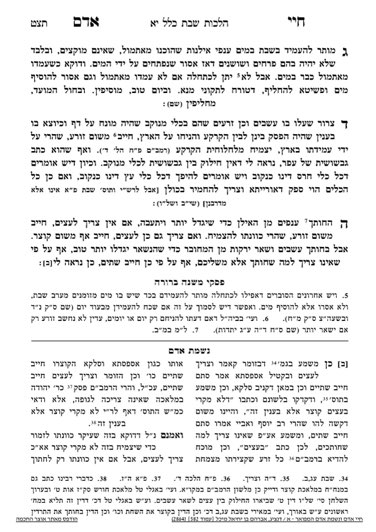Sponsorships for the upcoming Klalim, which discuss the 39 melachos of Shabbos, are available. Please contact Rabbi Reingold for more information at rabbireingold@gmail.com or 301.996.5910
We are beginning siman 5. The Gemara introduces the idea that a person can perform one action which has multiple results, and, consequently, be chayav for more than one melacha. The Gemara gives the example of pruning a tree. The purpose of pruning a tree is to facilitate growth of the tree, which is a form of zoreiah. If a person also plans to use the branches being pruned, he is also transgressing the melacha of kotzair, detaching something from its source of growth for the purpose of use. However, if the person only has intent for pruning, and plans to discard the branches, at worst it is a melacha she’eina tzricha legufah (doing the act intentionally but not for the purpose of the melacha kotzair). This is akin to digging a hole for the purpose of the dirt and not for the hole. Thus, the Gemara concludes that if one prunes a tree but does not need the branches, they are only chayav for zoreiah. If they prune the tree and need the branches, they are chayav both for zoreiah and for kotzair.
In this siman, the Chayei Adam discusses this Gemara. He writes that if one cuts branches off the tree so that it can grow, if they do not plan to use the wood, they are only chayav for zoreiah. The person’s purpose is to help the tree grow (because the sap which was being directed to those branches will be redirected to the trunk, thereby thickening it), so they are only chayav for zoreiah. If they intend to use the branches, they are chayav for kotzair as well.
Tosfos writes that even if one holds melacha she’eina trzircha legufa is chayav, if the primary intention is zoreiah, the person will still only be chayav for zoreiah and not for kotzair. Tosfos explains that since the person is not trying to do kotzair, but is actually doing the exact opposite (because pruning helps the tree grow), even the opinion that melacha she’eina tzricha legufa is chayav would agree that one is not chayav for kotzair over here.
To explain, we have learned (s313) that there are certain melachos where the action by itself is ambiguous enough that unless one has intent, it is not defined as a melacha. For example, if one takes a splinter off of a piece of wood to use as a toothpick, Rebbi Eliezer says they are chayav for makeh bepatish. However, if they take the splinter with no intent to make a toothpick, we do not consider it an act of creating a toothpick, but simply removing a splinter from a larger piece of wood. Similarly, over here, even the opinion that melacha she’eina tzricha legufa is chayav will agree that one is patur over here, since the intent will define whether there is an additional melacha of kotzair or if it is only zoreiah.
Summary
- If one prunes a tree for the purpose of helping the tree grow, they will only be chayav for zoreiah (even according to the opinion that melacha she’eina tzeicha legufa is chayav).
- If one prunes a tree for the dual purposes of helping the tree grow and for benefitting from the branches, their one action will make them chayav for both zoreiah and kotzair.



